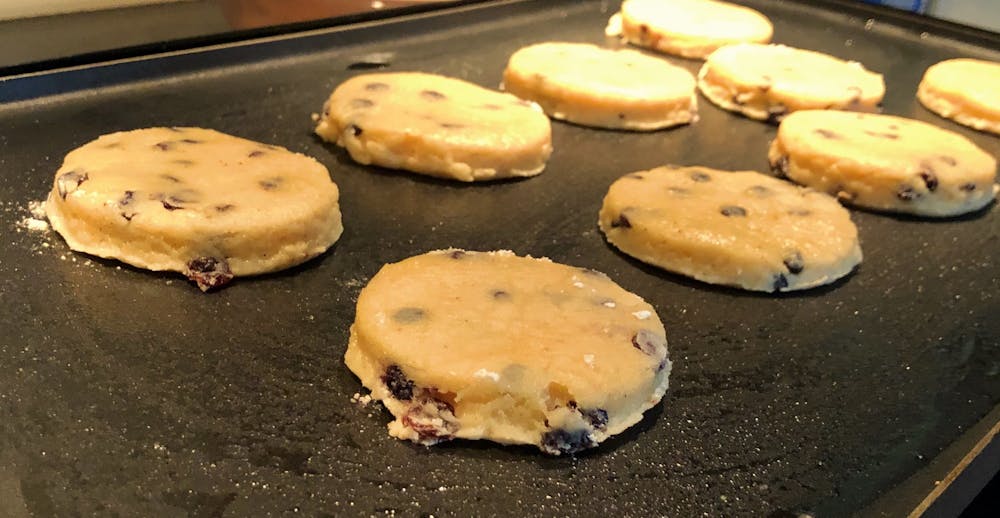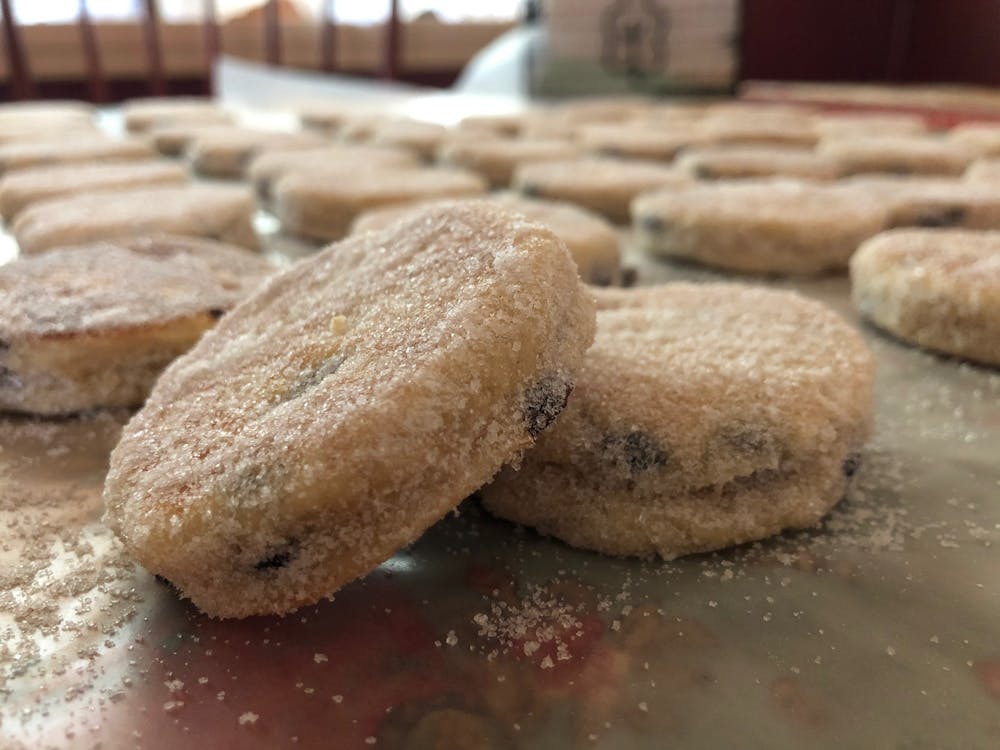In the heat of the unairconditioned kitchen, my grandma tells stories about her grandma to the music of the sizzling griddle and the spinning fan. As the hand of the outdoor thermometer creeps close to 100 degrees, I carefully roll out the cookie dough on the counter while my grandma — whom I call Mam — flips the cookies on the griddle.
As the child of two parents with full time jobs, I spent many summer days in this house at what we in the family jokingly call “Mam camp.” Mam showed me how to cook by feel more than recipe, to sew in the dark evenings by hand, and to love with a fierceness and grace I will spend my life trying to emulate.
Today, we’re making Welsh cookies. I grew up eating Welsh cookies with Mam, and my parents and I have become somewhat addicted to them during this quarantine summer.
I struggle to describe Welsh cookies to those who have never eaten them. Also known as Welsh cakes, the desserts are something of a cross between a cookie, a scone, and a biscuit. The sweet dough, which contains currants or raisins depending on preference, is cut into circles, fried and flipped (like a pancake) on a griddle, and (optionally, but in my opinion, preferably) sprinkled with sugar. The result is a reservedly sweet cookie with a soft, fluffy, tender texture.
The main recipe Mam and I are using is from a cookbook called “Cherished Recipes” from the Eatonville United Methodist Church of Eatonville, PA. The cookbook is from 1981, but I’m confident most of the recipes date back further — perhaps even to 1881, when the church was founded. Both Mam and my mother have a copy of the cookbook; Mam recognizes some of the typewritten names under the recipes as people she knew.
“Seven pounds of flour?” Mam exclaimed when I showed her the Welsh cookie recipe.
She pulled out a crinkled sheet of yellow lined paper and showed me the recipe she typically uses, written in her familiar handwriting laden with capital letters. The Eatonville recipe calls for twice the amount of flour.
We’re going to have plenty of cookies.

Welsh Cookies
Recipe edited from Muryl Marlatt’s in “Cherished Recipes” from the Eatonville UMC
Tips from my Mam (Marion Reilly) and me

Ingredients
7 cups flour
2 ½ cups sugar + more sugar for optional coating (see step 6)
2 tsp salt
3 tsp nutmeg
6 tsp baking powder
2 cups Crisco
1 ½ cups currants or raisins
3 beaten eggs
¾ cups milk
1. In a large bowl, mix flour, sugar, salt, nutmeg, baking powder, Crisco, and currants or raisins.
Mam insists on using real Crisco shortening when making these cookies. I’ve usually eaten Welsh cookies with raisins, but I bought currants this time around and really enjoyed how they turned out. An 8 oz. bag of Zante Currants should be just the right amount for this recipe.

Paige Allen / The Daily Princetonian
2. Add eggs and milk.
Mam beat these eggs and milk together separately before mixing into the dry ingredients. You’ll want to use your hands to get all of this mixed together into a dough. The flour should be fully incorporated, and the dough should feel cohesive.

Paige Allen / The Daily Princetonian
3. Take a portion of the dough (about the size of a softball), knead together, and place on a floured surface. Use your hands to flatten the dough to under an inch in thickness. With a floured rolling pin, roll out the dough to ¼-½ inch in thickness.
During this process, you don’t want your dough to crack. To prevent cracking, Mam recommends carefully rolling out the dough by putting your palms on the actual roller of the pin (rather than the handles), applying pressure, and rolling back and forth. By putting your hands on the roller itself, you can better feel the thickness of the dough beneath it. Be careful not to make the dough too thin.

Paige Allen / The Daily Princetonian
4. Using a round cookie cutter or the floured top of a drinking glass (like we did), cut the dough into circles.
You can make your Welsh cookies as big or as small as you’d like to. We’d recommend somewhere between two and three inches in diameter.

Paige Allen / The Daily Princetonian
5. Fry the circles of dough on a griddle, buttered and heated to 350 degrees (or 300 degrees, if you want a bit of a slower cook and some more control).
The cookies will rise a bit as they are being fried. When the “wet” side starts to get fluffy and airy, you’ll know that the bottom side is close to done, and you’ll be ready to flip the dough and cook the other side (just like a pancake!). The cooked dough should turn a light golden brown.
To flip the cookies, Mam recommends a metal spatula if you have it. She also says that it’s helpful to have a spatula that is flat at the lip rather than sloped. A smaller spatula can actually give you more control, but use what you’re comfortable with.

Paige Allen / The Daily Princetonian
6. Put the cookies into a container or bowl of granulated sugar, coating the outside in sugar.
This step is optional, and Welsh cookies are still great without the sugar on the outside, but given the option, I’ll always choose more sugar!
7. Place on metal racks or wax paper to cool.
8. Incorporate the leftover dough that wasn’t cut out in step 4 back into the rest of the dough in the bowl. Re-flour your surface and rolling pin, and repeat steps 3-7 until there’s no dough left.
This recipe makes about 80 cookies, so you’ll have plenty to share. You can also seal cookies in plastic bags and freeze them to eat later!

Paige Allen / The Daily Princetonian
As Mam and I eat our Welsh cookies, she tells me stories about when she was a young girl growing up in rural Pennsylvania. She looks at the spread of 80 cookies in front of us on the kitchen table, and she remembers how her grandmother got up at dawn to spend the day making food — and lots of it.
Sitting at that table, listening to my grandmother’s stories, I feel connected to a family that came before me — especially the women. Mam reflects on the limits she saw placed on women during her childhood, the lives they were often forced to lead. Though misogyny and heteropatriarchy still pervade our society, I feel lucky that, for me at least, the kitchen can be a place of joyful connection rather than confinement.
I wish I am recording my grandmother. I want to have her stories decades down the line, in her own voice. When I am her age, I hope I can listen to her by making her recipes and handling food in the intimate, careful ways she does — like flipping a hot, half-cooked Welsh cookie into her palm to check the color of its underside.
Now, as we talk and eat together, I can hear her and the women who came before, who also spent hot summers with flour on their clothes and dough in their hands.







